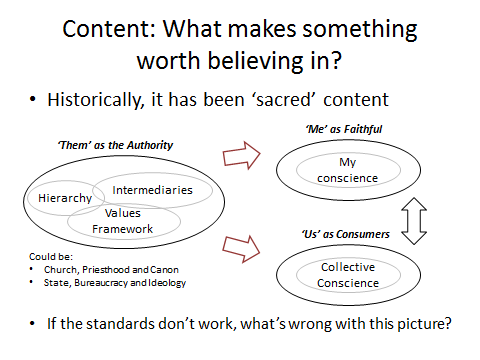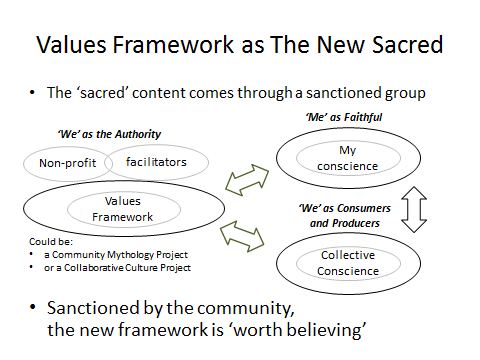Last year I prepared a talk for the New Livelihoods Job Fair in Fall City, WA. The gist of my talk was that as we shift what we value, we can also shift our economy. Art can play a key role in that. For example we have to shift from a mode where the individual or an institution is consuming content created by other individuals or institutions, to a mode where a community creates art in concert based on the agenda set by the community. I talked about the virtuous cycle of creating, embellishing and consuming art based on shared story, which I’ve described elsewhere and I won’t recap here. However, I did ask one question which has not been blogged, and which addresses the economic question.
The fact that interesting art can drive commerce is not a new concept. However, so many local arts attractions don’t have a greater purpose. There was talk in Duvall about having a piano drop because years ago that was a defining moment in local lore: a piano was dropped from a helicopter. The concrete Troll under the bridge, along with a rocket lodged in a building, a statue of Lenin and countless other weird stuff brings people to Freemont, WA, and that drives their commerce. Another example is the work of muralists in towns who paint very graphically interesting commercial subject matter. All of these can be interesting if not gimmicky; it is pop culture driving commerce. Can we drive commerce with something more meaningful?
The question then becomes about special content, and adoption of that content. While it’s not hard to get people to gawk at trolls or dropping pianos, driving adoption of a mythology with values requires shifting people’s minds. We have to both overcome the hold of the old mythology and gain adoption of the new. What drives adoption of a meaningful cultural phenomenon?
I had been thinking of the shared Christian story during the Renaissance in Florence, and how the economy around it worked because there was broad adoption. Church, artists, businesses and consumers all contributed to the great rebirth of culture. It was largely driven by the church and government institutions which we don’t necessarily want to recreate, right? So how do we achieve the same effect? Perhaps looking at the perspective of the consumers will help – what was it in their minds that drove them to participate? Regardless of where the message came from, what was the dynamic in the minds and souls of the faithful that made them adopt it? The answer is sacred content. The following two slides from that presentation address topic.
I adopt what I believe in, and if the content is sacred, then it is beyond question. Why do pilgrims line up to shrines of the Virgin, Buddha, dead (divine) kings or even Elvis? An authority has determined these are sacred and therefore worthy. Note that this authority is external to me as a faithful participant or consumer. The Authority establishes a values framework, a ruling hierarchy directs and stewards the sacred content, and a host of intermediaries that carry it out to the faithful consumers. We now have a strong distrust of authority, which has lost all legitimacy:
- We don’t believe in elections because they are controlled by two self-serving political parties that are in the back pocket of corporations.
- We’ve been betrayed by big banks that helped us get into loans we couldn’t afford. They’ve squandered our retirement savings and continue to lose money with risky investments.
- We’re fighting intractable and unwinnable wars for what? Oil? We don’t believe in just wars.
- The understaffed regulators who are supposed to be protecting our environment are asleep while big corporations permanently damage the environment by mining and drilling for non-renewable sources of energy.
- Farmers can’t even save seeds for next year because they have been genetically modified by Monsanto, and the authorities are protecting the patents.
- Politicians change their stories with the winds of election polling and don’t keep their promises.
- Priests are preying on the young boys they should be nurturing into godly men.
- The courts are passing rulings that allow foreign entities to fund candidates without limits.
- and on and on it goes . . .
All around us there’s a collapse of the legitimacy of authorities, with much cynicism from the population. There’s never been a greater need for sacred content that can be trusted and deemed legitimate. How to achieve it without authorities? This is where we have to pivot our minds. We have to replace the dynamics of creation of sacred content within the authority to something else. This slide suggests an alternative:
We can create a values framework using collaborative culture techniques like community mythology projects. Out of these come sacred content that is legitimate because we created it according to shared values and a collective conscience. We have to put in place processes and rituals to establish, enshrine and communicate it.
That sacred content, together with excellence in art, can have an impact beyond commerce. Many communities have institutions dictating sacred content that don’t achieve an economy of culture. There no substitute for high quality production: excellence has its own logic (more on that later). When paired with sacred content, adoption is all but guaranteed.
— Roy Zuniga
Carillon Point, WA
copyright 2012 roy zuniga – all rights reserved


